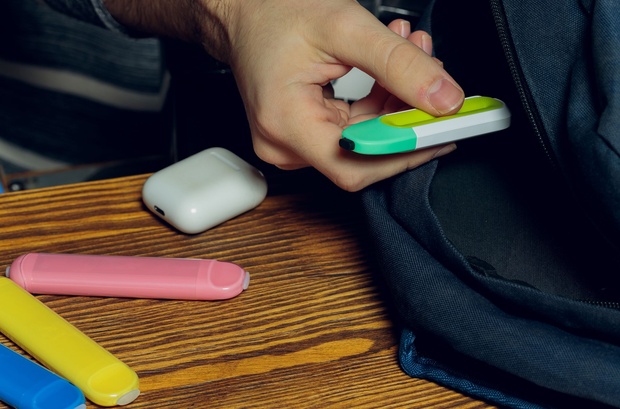The warning from behaviour change expert Timo Dietrich comes as the Government launches its new national $63.4 million anti-vaping and anti-smoking campaign that pushes young vapers to question ‘why are we still doing this?’
Deitrich is the founder of Blurred Minds, an academy that intends to shift students’ beliefs about alcohol, drugs, vaping and tobacco via targeted school workshops and online programs.
Having delivered around 200 anti-vaping sessions to students in the past year, the Associate Professor from Griffith University says the word from educators on the ground is that students have devised a raft of secretive means to conceal their vaping habit at school.
Others are wearing nicotine patches in class to get through the day, he suggests.
“What we’re definitely hearing and seeing is that there is that risk, that once you’re addicted to the nicotine component, then you basically don’t care how you administer the nicotine into your [bloodstream].
“[And] because schools have been very aware of the (vaping) issue, and they’ve been trying to crack down either with educational and/or punitive measures, students have also gotten more crafty at hiding the behaviour,” Dietrich says.
Despite vaping sensors in bathrooms and teachers on high alert, the expert says that anecdotally, many schools are still grappling with a huge vaping problem.
And unlike cigarette smoke that is relatively easy to detect, vape mist can be concealed by innocuously blowing into a shirt sleeve, school backpack, or by taking tiny inhalations at a time, Dietrich says.
“If you think about the (nicotine) pouches, they can be very potent and even more easy to hide when you can basically just place them in your mouth and still release a large quantity of nicotine …
“Or if you do use a vape … you just take a tiny [inhalation] as you move from location A to location B, or you even swallow repetitively, so that less smoke ultimately will come out.”
Reportedly one in 10 14-17 year-olds currently vape, representing a five-fold increase since 2019.
For 18-24-year-olds, vaping rates have quadrupled in the same period to 21 per cent, with smoking rates now on the rise for the first time in 25 years.
“Certainly we have heard the anecdotal evidence that there is a bit of dual use [by students],” Dietrich adds.
Griffith University research fellow Dr James Durl delivers Blurred Minds workshops in schools and says the demand is only increasing.
“Even before you set foot on the ground, you get this sense that either the issue is getting worse, or schools are waking up to the issue as it was, or a combination of both,” he says.
“But then when you get boots on the ground, there's a certain look the teachers will give you.
“You’ll ask them, ‘how’s the vaping situation at school? Have you noticed an issue?’ And they’ll turn and they’ll look at you with that knowing look, as if ‘you betcha’.
“They might dance around it, but they always end up saying yes…” he tells EducationHQ.
At the conclusion of the one-hour sessions with students, Durl says there’s often a wide-eyed bunch of educators waiting in the wings.
“They already knew there was an issue they needed to deal with, and now they feel like, ‘holy crap, this issue is bigger than we thought it was, and there’s a lot more to it than we ever considered’.”
Rather than highlighting vaping’s dangerous risks to health, the Government’s new anti-vaping campaign focuses on addictiveness, users’ loss of control and social isolation, with lines such as “it can be hard to resist its pull” seeking to hit the message home.
It will harness the reach of TikTok and other social media platforms to reach young people.
Health Minister Mark Butler says the Government has been “closing every one of the loopholes left by the former government’s failed vaping policies”, including closing the border to non-therapeutic vapes and introducing legislation to prevent their commercial possession, sale, supply and manufacture.
“In their entire nine years, the former government never mounted a public health campaign on vaping, nor a national population-wide campaign on smoking.
“Nicotine is highly addictive and before you know it, what starts as an occasional thing becomes something much more serious. But it’s never too late to quit,” Butler says.
The communications piece is a critical tool in the fight against the influence and carefully constructed narratives of Big Tabacco, Dietrich says.
“We’re trying to shift beliefs,” he says.
“When you think about the majority of content around vapes, that you see online and digitally … it shows us there’s more positive content out there, and therefore, the general belief system is skewed.
“There’s thinking that vapes are, for example, healthier than traditional tobacco smoking, or for some reason, maybe even something that is OK for young people to do, because there’s been a big push and promotion for many, many years around the globe, orchestrated by Big Tobacco, Big Vape, in order to shape these beliefs,” the expert says.
According to Dietrich, vaping education needs to go beyond a focus on health.
Students ought to be aware of the slick marketing tactics used by Big Tobacco to hook more young people onto their products, he says.
“We start [taking] that wider lens of media literacy, and [prompting them to consider] ‘how the kids are being manipulated? How is it being put in front of them so that they make a ‘yes’ choice instead of a different choice?’” he notes.
Durl welcomes the Government’s new campaign and the significant funding commitment behind it, but warns there is no one mechanism that we can rely on to solve society’s vaping problem.
“I do like the approach the Government’s taking … I do recall noticing a very heavy emphasis on common sense, which I do resonate with, but I think the younger generations, these guys know vapes are bad for them.
“So, there is a limit to how much that message will be effective…"
It pays to remember we’re dealing with a whole spectrum of vaping resilience, interest and addiction amongst young people, the researcher says.
“There are kids who have tried it, but don't continue to, there are kids who have tried it and are maybe using it a bit more of a time, there are kids that are falling asleep with a the vape in their hand and it’s their most prized thing, they can’t lose it,” he elaborates.
“This is one of those reasons why a combination of approaches is good.
“So, I’m not going to downplay the Government's efforts, I’m going to welcome those ads and say that’s another type of messaging – and even if they don’t prove successful for all kids, if there’s any kid out there that gets something out of those messages, then that’s $64 million well spent.”
















